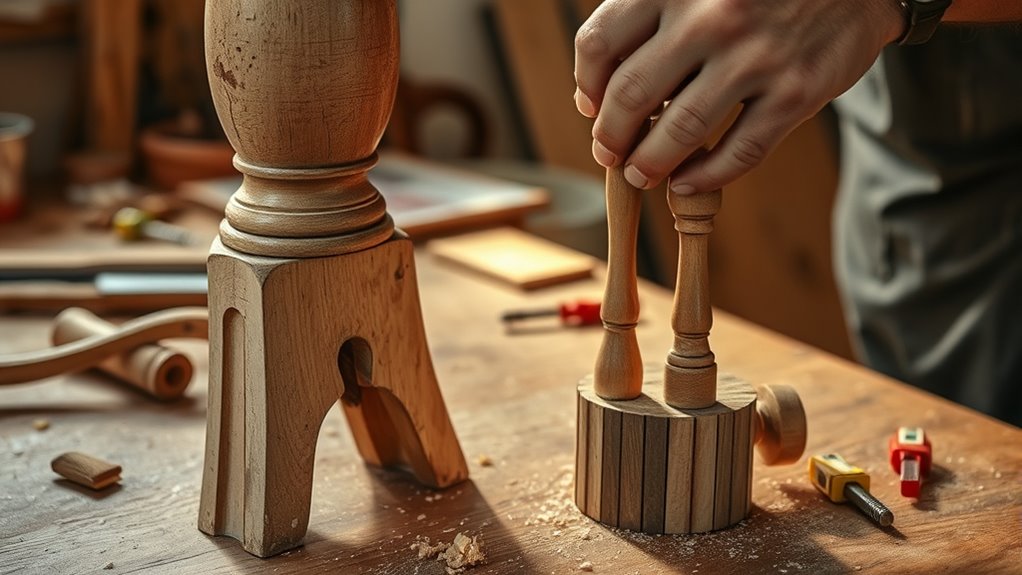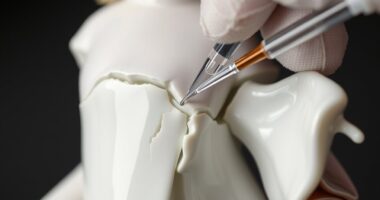To restore broken table legs and chair spindles, first assess if the damage is clean or complex. Clean the surfaces, fit the pieces together, and remove old glue residues. Apply quality wood glue, clamp firmly, and allow sufficient curing time. Reinforce joints with nails or screws for added strength, and sand smooth once dry. For best results, patience and proper techniques are key—continue on to discover detailed steps for a seamless repair.
Key Takeaways
- Evaluate the break to determine if it’s clean or complex, then clean and fit pieces before gluing.
- Apply high-quality wood glue generously, clamp securely, and follow curing instructions for strong adhesion.
- Replace damaged spindles or legs by removing old parts, matching dimensions, and securing with glue and nails or screws.
- Sand rough edges and excess glue after drying, and reinforce joints with dowels or corner blocks for added stability.
- Patience during curing and proper finishing ensure a seamless, durable repair that extends furniture lifespan.

When a table leg or chair spindle breaks, it can seem like an impossible fix, but with the right approach, you can restore your furniture to its former strength and beauty. The key is to assess the damage carefully and choose the right materials and techniques. If the break is clean and the pieces fit well, you can often repair it with wood glue. Make sure the surfaces to be glued are clean, dry, and free of dust or old glue residue. Apply a generous amount of wood glue to both broken surfaces, then press them together firmly. Clamp the pieces securely and let the glue cure according to the manufacturer’s instructions, usually for several hours or overnight. Once the glue has set, check the joint’s strength and integrity. If the break is complex or the damage extensive, replacing the spindle might be the better option. Replacement spindles are readily available at furniture supply stores or online, often designed to match the original dimensions and style of your furniture. To replace a spindle, carefully remove the damaged part, taking note of how it was attached—whether glued, nailed, or screwed. Use appropriate tools to detach it without damaging the surrounding wood. When installing the new spindle, apply wood glue to the contact points to ensure a strong bond, then secure it in place with nails or screws if necessary. Clamping the new part while the glue cures helps achieve a tight fit and maximum strength. If your furniture has decorative elements or intricate joinery, take extra care to preserve or replicate those details during the repair. Sand any rough edges or excess glue once everything is dry to blend the repair seamlessly with the surrounding wood. For added stability, you might consider reinforcing the joint with small dowels or corner blocks, especially if the piece bears weight or frequent use. Always test the repaired area gently before putting the furniture back into full use. Restoring broken table legs and chair spindles can be straightforward when you use quality wood glue and choose the right replacement parts when needed. Patience during the curing process ensures a durable repair that can last for years. Additionally, understanding furniture repair techniques can greatly improve your success rate. Keep in mind, sometimes a professional touch is worth considering, especially for antique or valuable furniture. But with the right tools and a bit of care, you can confidently restore your furniture and extend its life. Your efforts will not only save money but also give you a satisfying sense of accomplishment.
Frequently Asked Questions
Can I Repair Antique Table Legs Without Damaging Their Value?
Yes, you can repair antique table legs without compromising their value if you focus on vintage preservation and antique restoration techniques. Use gentle, non-invasive methods to fix cracks or breaks, and avoid replacing original parts. Carefully match the wood and finish to maintain authenticity. Consulting a professional ensures the repair blends seamlessly, preserving the piece’s historic charm and value for future generations.
What Tools Are Best for Restoring Delicate Chair Spindles?
You might think delicate chair spindles require special tools, but the truth is, using wood glue and fine brushes works best. First, carefully clean the broken surfaces. Apply wood glue precisely with a fine brush to avoid excess. Hold the pieces firmly until they set. This gentle approach preserves the spindle’s detail and integrity, ensuring a seamless repair that maintains the antique’s value and beauty.
How Long Does a Typical Repair Take for Broken Legs?
A typical repair for broken legs takes about 1 to 3 hours, depending on the extent of the damage. You’ll start by applying wood glue to the broken surfaces, then hold the pieces securely in place. Allow the glue to dry for at least 24 hours to guarantee a strong bond. Rushing the drying time might weaken the repair, so patience is key for a durable fix.
Is Professional Restoration Necessary for High-Value Furniture?
If you have a valuable antique, professional restoration is often worth it. For example, a vintage dining table with intricate carvings might look fine after DIY repairs, but a professional can preserve its value and authenticity. Though costs are higher, professional restoration guarantees quality and durability, making it a smart investment compared to cheaper DIY techniques that might reduce its worth. You’ll get lasting results and peace of mind.
Are There Eco-Friendly Adhesive Options for Furniture Repair?
Yes, there are eco-friendly adhesive options for furniture repair. You can use biodegradable glues and plant-based adhesives, which are safe for the environment and non-toxic. These options work well for fixing broken parts like table legs and chair spindles, providing strong bonds without harmful chemicals. Switching to biodegradable glues guarantees your furniture repair is eco-conscious, helping reduce your carbon footprint while maintaining durability and stability.
Conclusion
Don’t let broken table legs or chair spindles keep you from enjoying your furniture. With patience and the right glue, you can restore their strength and beauty, making them look almost new. Imagine yourself confidently gluing and clamping, knowing that your efforts will bring life back to your cherished pieces. Even if you’ve never done this before, you’ll surprise yourself with how satisfying and rewarding it is to see your furniture restored and ready for years to come.









